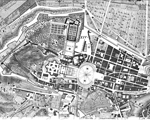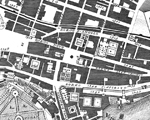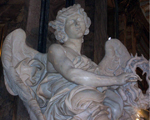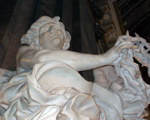A BIT IN DEEP: BERNINI AND THE BAROQUE SCULPTURE
The Bridge of the Angels took on its current appearance in 1671, shortly before Bernini had complete, in 1665, the colonnade of St. Peter's Square.
It was approaching the jubilee of 1675, which had to drive to Rome a great multitude of pilgrims. At that time, along the Tiber, after the Milvian Bridge, the first bridge that one could meet was just the Sant'Angelo bridge and down as far as the Sisto bridge there was no one else, so the pilgrims, who by all means, came from north, and part of those who came from the south, had to cross the river along the Sant'Angelo bridge.
From here they would be headed to St. Peter's Square to pray at the tomb of Peter, which was their ultimate goal.
Then there wasn’t the awful Conciliazione street, therefore the pilgrims, to arrive into San Pietro square, crossed the “Borghi” (an ancient quarter), and walking along Borgo Vecchio, or Borgo Nuovo (two narrow roads), suddenly they were in the immensity of the square, greeted by St. Peter church, which encircled them with its colonnade.
 |
 |
 |
| The map of the Borgo -
click to enlarge |
The transition from the narrow tangle of Borghi to the vastness of the square, the immensity of the facade of the basilica, the spire of the dome, had to be extraordinarily exciting and enthralling, according to the intentions of the great artists who put their genius to the service of faith, let's talk about Raphael, Antonio Sangallo the Younger, Michelangelo, Giacomo della Porta, Carlo Maderno and Bernini.
With the unfortunate opening of Conciliazione street the quarter mamed “Spina dei Borghi” was destroyed, Borgo Vecchio and Borgo Nuovo, have been incorporated into the main road, Scossacavalli and Rusticucci square have been lost, but especially is lost forever the amazing emotion of being suddenly in St. Peter's Square.
In preparation for the Jubilee of 1675 Pope Clement IX Rospigliosi wanted the pilgrims, crossing Sant'Angelo bridge, were entering the last part of their journey of faith, in the name of Christ. He then entrusted Gian Lorenzo Bernini of representing the Passion, which for the Christian is the ultimate gift of Jesus.
Bernini, sketched ten angels, each of whom symbolizes the episodes of the Passion, and called to sculpt the best artists of the time. At that time disappeared Stefano Maderno (1570 - 1636), Francois Duquesnoy (1597 - 1643), Francesco Mochi (1580 - 1654) and Alessandro Algardi (1598 - 1654), the greats were: Ercole Ferrata, Ercole Antonio Raggi, Domenico Guidi, Cosimo Fancelli. Each of them carved an angel, while the 6 others were sculpted by Bernini himself and his close aid: Lazzaro Morelli, who had carved more than 20 of the 144 Saints who are on the balustrade of the colonnade of St. Peter's Square, Paolo Naldini, Gerolamo Lucenti and Antonio Giorgetti, the youngest of them all.
Two angels carved them Bernini himself, but considered too fine to be exposed to the weather, they were replaced by as many copies, and the originals today one can enjoy in Sant'Andrea delle Fratte, near Piazza di Spagna.
|
| The original by Bernini at Sant'Andrea delle Fratte |
The pilgrims (and we Romans too), were and are greeted at the entrance of the bridge from St. Peter and St. Paul.
These two statues existed prior to the intervention of Bernini, it was another Clement, Pope Clement VII de' Medici, who in 1535 placed them where they are. The Statue of St. Paul is the work of Paolo Romano, of whom we know neither the date of birth, nor that of death, we only know that he worked in Rome in the second half of '400. The statue was originally located at the entrance to the Sistine Chapel, while the statue of St. Peter is due to Lorenzetto, one of the aids of Raphael.
On the pedestal of the statue of Peter is written: "Hinc humilibus pardon" (Here's forgiveness to the poor), while Paul says: "Hinc retributio proud" (Here the proud will be punished).
Phrases singularly reminiscent those of the sixth book of Virgil's Aeneid: "Parcere subiectis et debellare superbos" (Forgive the submitted and punish the proud).
Entered the bridge on our right we see the angel with the column,
of the greatof Ercole Antonio Raggi (1624 – 1686), which is the first station of the Passion: Christ tied to the column to be scourged. The writing on the base says: "Tronus meus in columna" (My throne on a column).
In the second station, the first angel on the left by Lazzaro Morelli (1619 – 1690), holds the flagella. On the base the words: "In flagella paratus sum" (I'm ready for the scourging).
The third station is represented by the beautiful angel of Bernini with the crown of thorns. Here we see a copy made by Bernini himself with the help of Paolo Naldini.
The original is in the church of Sant'Andrea delle Fratte.
 |
 |
 |
 |
| The angel with the crown of thorns, original by Bernini at Sant'Andrea delle Fratte -
click to enlarge |
On the base is written: "In Aerumna mea dum configitur spina" (During my pain a plug stuck).
The Fourth Angel, by Cosimo Fancelli (1618 – 1688), shows the Shroud,
the cloth that Veronica gave to Jesus to mop up the blood and sweat, on which remained the appearance of His Face. The inscription said: "Respice faciem Christi tui" (Look at the face of thy Christ). It said but in 1800 a bullet has damaged the inscription, that with subsequent grouting has disappeared. Hopefully not in a definitive way.
The fifth angel, by Paolo Naldini (1619 – 1691), holds in his hands the garment of Jesus.
The inscription says: "Super Vestem meam miserunt sortem" (They cast lots for my garment).
In the sixth station the angel with nails, by Girolamo Lucenti (1627 – 1692), says: "Aspiciant ad me quem confixerunt" (They look at me who crucified).
The angel with the Cross is the work of another of the great Baroque sculptors, Ercole Ferrata (1610 – 1686). The inscription says: "Cuius principatus super humerum eius" (His Kingdom is on his shoulders).
The eighth angel holds the inscription INRI (Iesus Nazarenus Rex Iudeorum = Jesus of Nazareth King of the Jews) and says: "Regnavit a ligno Deus" (God reigned from the Cross).
 |
 |
 |
 |
| The angel with the inscription INRI, original by Bernini at Sant'Andrea delle Fratte -
click to enlarge |
The original by Bernini, like the previous one is in Sant'Andrea delle Fratte, the copy is the work of Giulio Cartari (1640 - ?), very dear to Bernini, who had been his student at age 18.
In the ninth station, the angel with the sponge,
by Antonio Giorgetti (1635 – 1669), says: "Potaverunt me aceto", (They quenched my thirst with vinegar).
The last angel with a spear in his hand,
by the great Domenico Guidi (1625 – 1701), says: "Vulnerasti cor Meum", (You wounded me to the heart), remembering the spear of the centurion.
Those who are far from faith, along the bridge will admire the beauty of the sculptures, a true anthology of the Roman Baroque, an anthology which you can see via the links in red.
Who has the Faith will be moved.
To those who laically doubt we suggest to try (or discover), the metaphorical meaning of this Via Crucis.
back |

